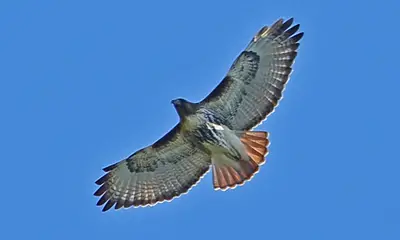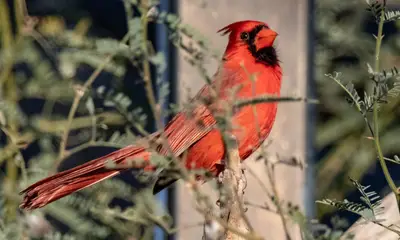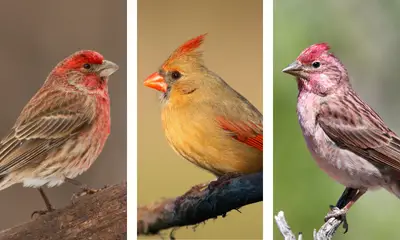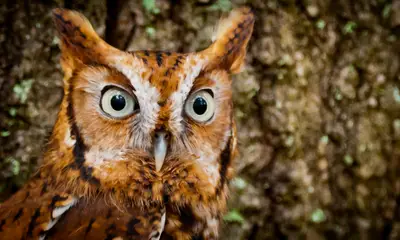13 WHITE Birds With BLACK TIPPED Wings (ID Guide With Photos)
Did you recently come across a white bird that had black tipped wings, and want to know what species it was?
Identifying white birds that have black tips on their wings is not as easy as it might seem, since there are surprisingly many birds in North America that fit this description.
To help you identify the bird you saw, we’ll cover the most important white birds with black tipped wings in North America.
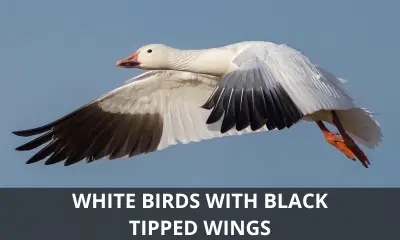
What types of white birds have black tipped wings?
There are 13 types of birds in North America that have a white body and black tipped wings, which are covered in full detail below.
Snow Goose
Scientific name: Anser caerulescens
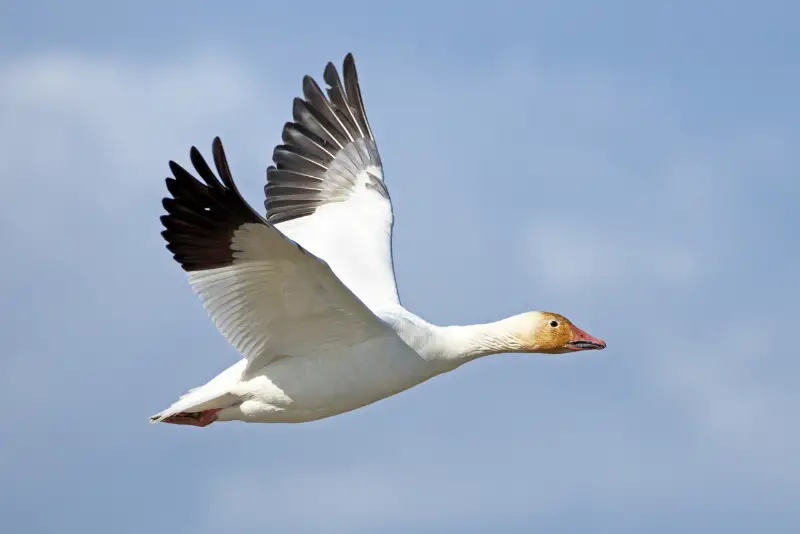
Similar to Trumpeter Swans, Snow Geese are winter visitors in the United States, but the number of wintering Snow Geese has rapidly increased in recent years.
The Snow Goose exists in two color morphs, one of which is entirely white, while the other is blue gray with a light cream head. Both of these have black wing tips.
The Arctic population of Snow Geese has gone up significantly in the past few decades, and as result it is also much more common in its wintering grounds.
Snow Geese like to feed on harvested farmland, such as wheat fields, where these birds feed on leftover grains. In some cases these birds also forage on rice fields.
Swallow-tailed Kite
Scientific name: Elanoides forficatus
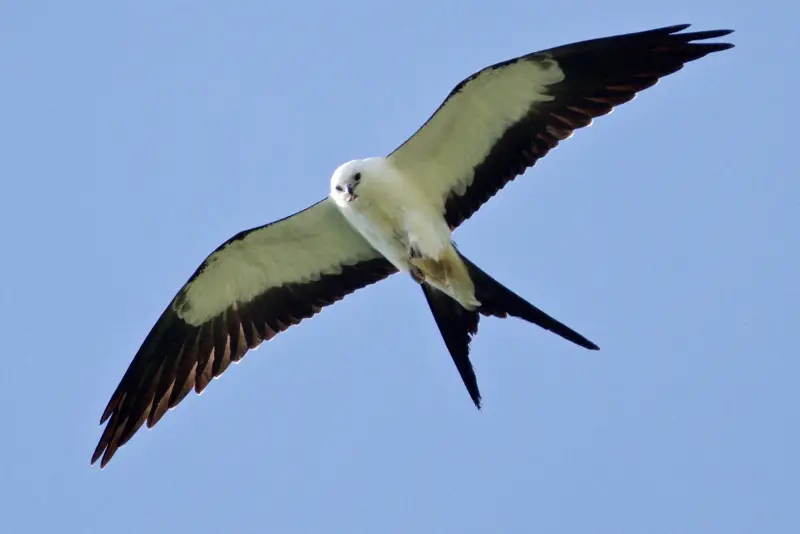
This elegant white bird of prey is easy to identify in flight, due to the combination of its bright white underparts with its deeply forked tail.
The rear margins of the wings and the tail are black. When perched on a tree, its white head and chest contrast with the dark grayish black upperside.
Similar to other kite birds, this bird is a skilled hunter and capable of catching insects in flight. Its preferred food are small reptiles, rodents, and insects.
The Swallow-tailed Kite is a summer visitor in the southeastern United States, and migrates to Central and South America to spend the winter.
American White Pelican
Scientific name: Pelecanus erythrorhynchos

The American White Pelican is one of the largest aquatic birds in North America, and is almost entirely white, except for black feathers on its wing tips.
These birds breed in the northern US, and spend the winter along the Gulf Coast, as well as in Florida and California.
With a wingspan of up to 10 feet, and a body weight of up to 30 pounds in males, the American White Pelican is the biggest white bird in North America.
This bird feeds almost exclusively on fish, but unlike other pelican species it doesn’t dive in order to catch them. Instead it submerges its head down into the water, and grabs fish with its large beak.
Their preferred habitat are estuaries, shallow bays, and coastal inlets, as well as freshwater lakes further inland.
White Ibis
Scientific name: Eudocimus albus

This large bird is easy to recognize due to its generally white plumage and long vividly orange colored beak that is curved downwards, as well as its long white wings that have black tips.
During the first two years of their lives, immature White Ibises have a chocolate brown body with light streaks and a pale orange beak.
While it is most commonly found in coastal areas, the American White Ibis prefers to forage in freshwater habitats.
The White Ibis feeds on fish, insects, crayfish, and other crustaceans. Crayfish form a large part of its diet in areas where they are common.
Whooping Crane
Scientific name: Grus americana
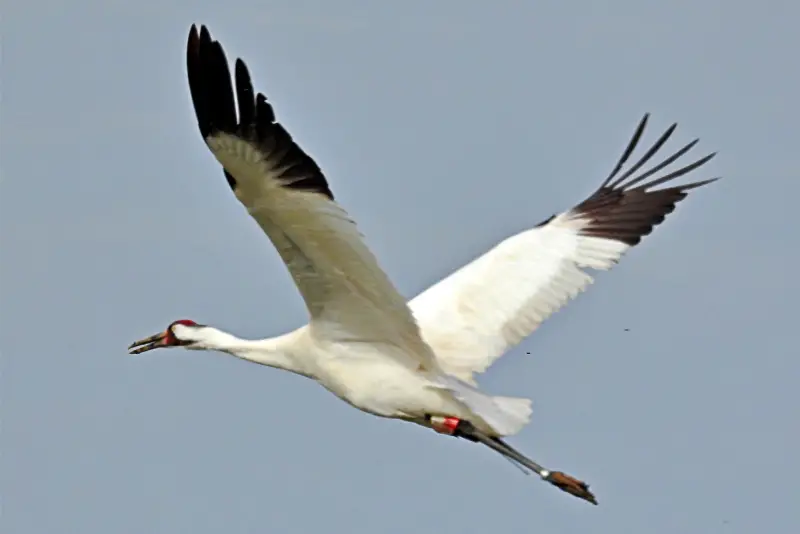
The Whooping Crane was a critically endangered species, and at the brink of extinction in the 1930s, with less than 20 birds remaining.
However, sustained conservation efforts have brought it back to a current population that numbers about 600 birds.
Adult Whooping Cranes have a completely white body, except for their black wing tips and red cap that consists of bare skin. In contrast to adults, juvenile birds have a reddish brown color.
Whooping Cranes breed in Alberta, Canada, as well as Wisconsin, and migrate south to spend the winter in southern states.
During the non-breeding season, the preferred habitat of Whooping Cranes are wetlands, marshes, estuaries, and salt flats.
Ring-billed Gull
Scientific name: Larus delawarensis
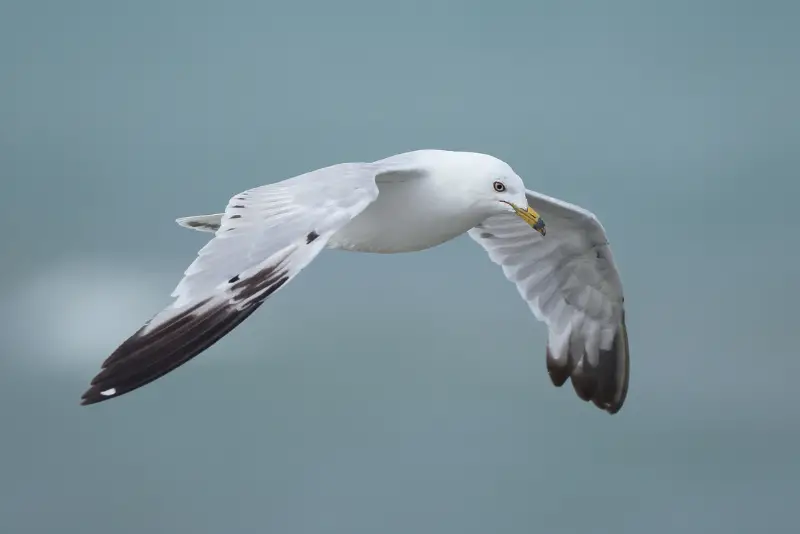
The Ring-billed gull is a breeding bird of northern North America, as well as a common winter visitor in southern states of the US.
Adults are almost entirely white, except for their light gray upperparts and black wing tips. The legs and the bill are bright yellow. Juvenile birds are more mottled in appearance, with a mix of brown and gray.
This bird can be confused with the Herring Gull, but the latter is more rare, while the Ring-billed Gull is quite common on large lakes and reservoirs.
Laughing Gull
Scientific name: Leucophaeus atricilla
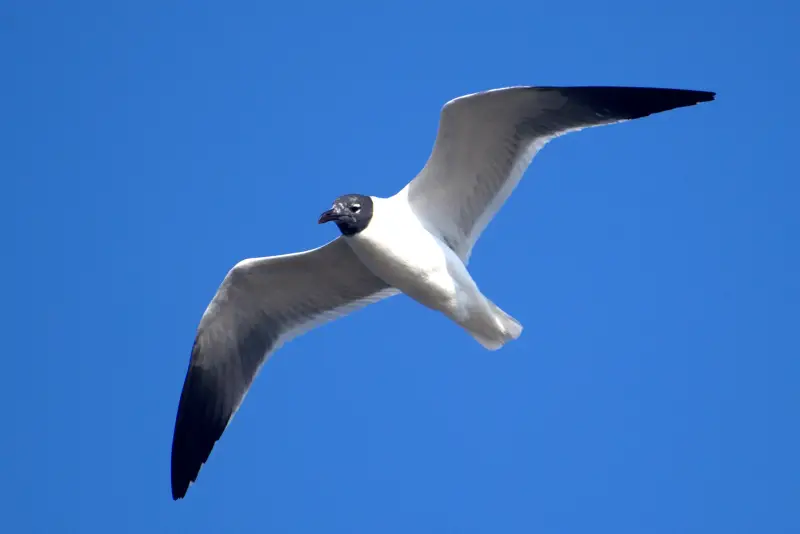
The Laughing Gull is common along the entire East Coast, and can be easily identified by its black head and its loud call that resembles human laughter.
Adult Laughing Gulls in summer are predominantly white, with a black head and wingtips, as well as a gray upperside.
Both the bill and the legs are dark red. In contrast to adults, juvenile birds are pale gray brown.
Laughing Gulls are most common close to mud flats and sandy beaches, but these birds also occur away from land, foraging over open water.
Herring Gull
Scientific name: Larus argentatus
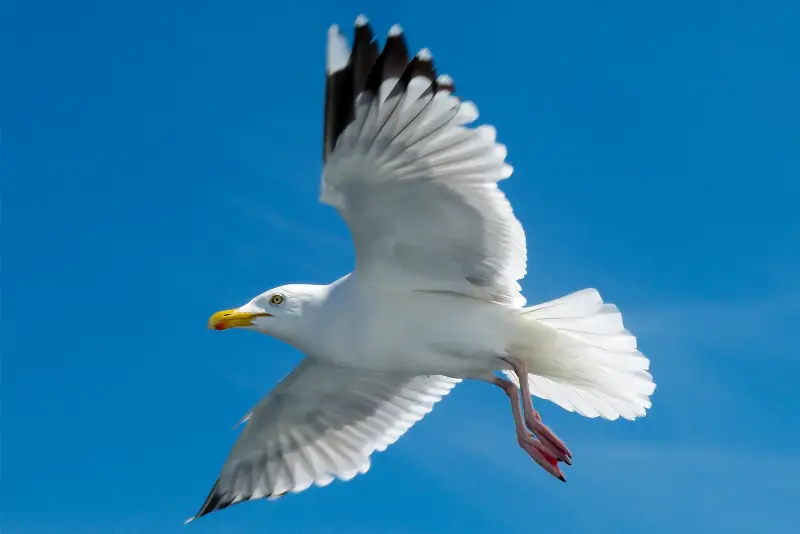
The Herring Gull is a breeding bird of the arctic tundra, and a common winter visitor in large parts of the United States. It is a scavenger, and likes to frequent landfills and garbage dumps.
This is a large gull with a white head and underparts, as well as a pale gray mantle and black wing tips. During the winter it has gray speckles on its neck and head.
Apart from scavenging, it also feeds on fish, mollusks, and crustaceans.
It is a very intelligent bird, and likes to drop shellfish from a great height in order to crack their shell open and feed on the soft interior.
Bonaparte’s Gull
Scientific name: Chroicocephalus philadelphia
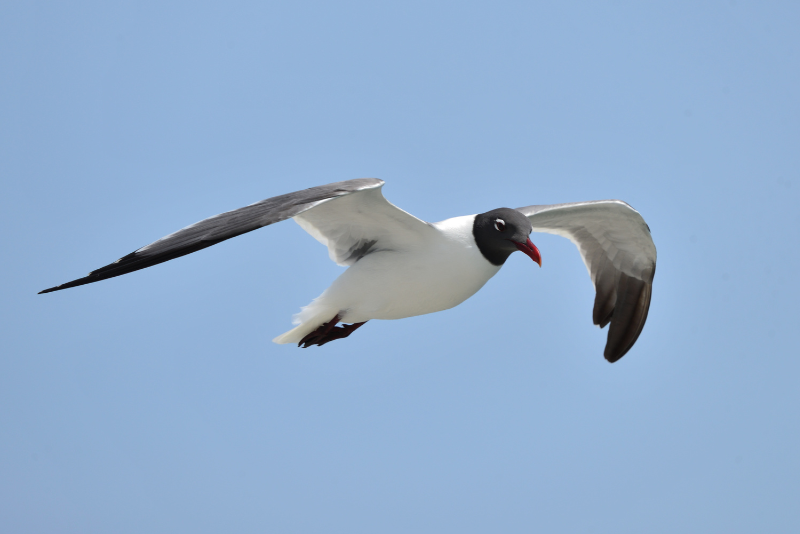
Bonaparte’s Gulls are breeding birds of northern Canada, where they breed along the coasts of rivers and lakes.
These small gulls are largely white, except for a jet black head during the breeding season, as well as black wingtips and a light gray mantle.
They can be found throughout the North American continent during migration, and winter along the east and west coasts, as well as in the caribbean.
Franklin’s Gull
Scientific name: Leucophaeus pipixcan
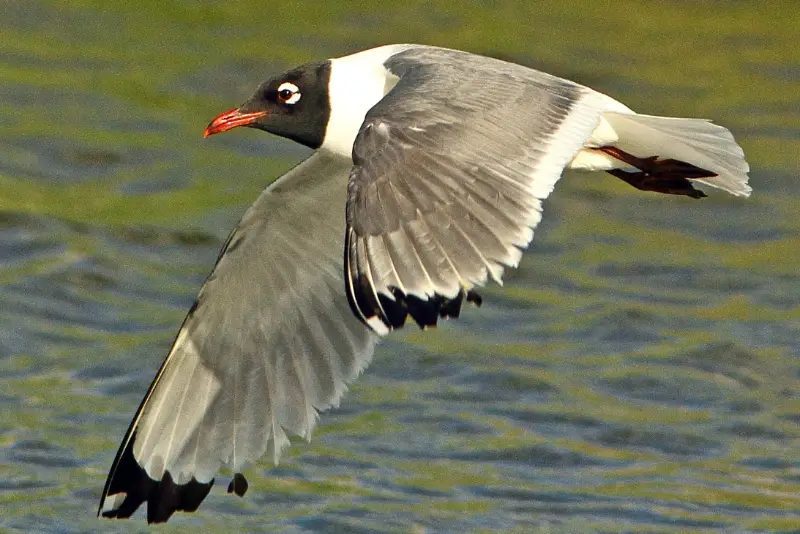
These small gulls breed in the marshlands of northern North America.
They are also commonly encountered in the United States while migrating from their breeding grounds to their wintering grounds in South America.
Adults in breeding plumage have a large white body, with a light gray mantle and a black head, as well as black-tipped wings.
Immature birds and nonbreeding adults lose most of their black head feathers, except for a patch behind their eyes.
California Gull
Scientific name: Larus californicus
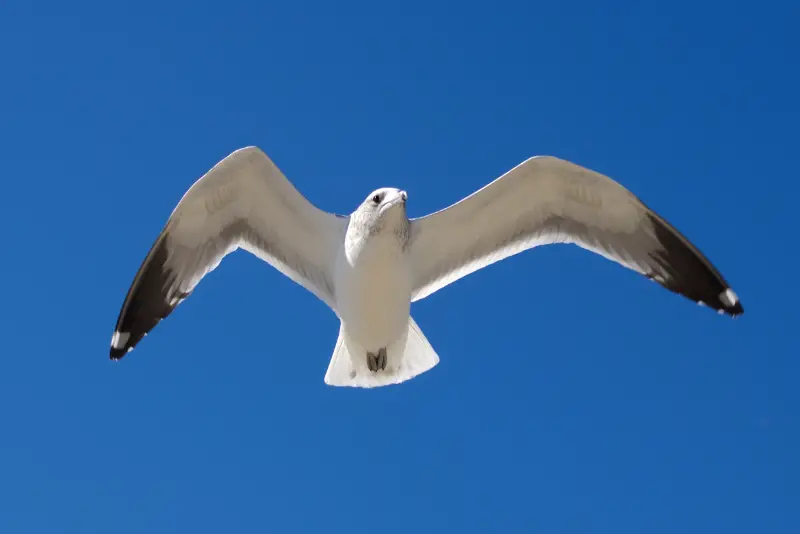
These medium-sized gulls are almost entirely white, except for their gray mantle and the black wing tips.
They breed on inland water bodies, including lakes, marshes, and rivers, but forage miles away from their breeding colonies, and so can be encountered over land as well.
They spend the winter months along the entire west coast of the United States and Mexico.
Northern Gannet
Scientific name: Morus bassanus
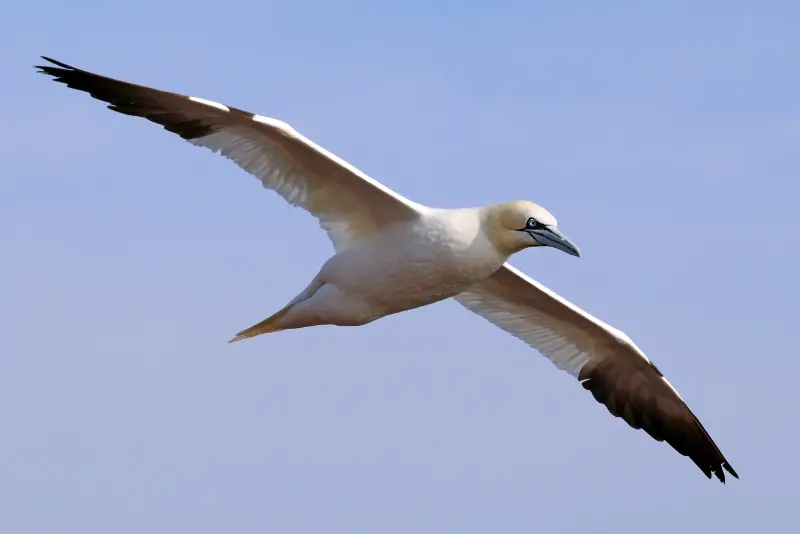
These birds are impressively large and are nearly as big as albatrosses. They have a largely white body with black wingtips, and a small dark mask.
If you see these big birds, notice how fast they dive in order to catch their food, and plunge into the water only to resurface with a mouth full of fish.
Northern Gannets nest on the cliffs of northern North America, but winter along the entire coastline of the eastern United States and the Gulf Coast.
Snow Bunting
Scientific name: Plectrophenax nivalis
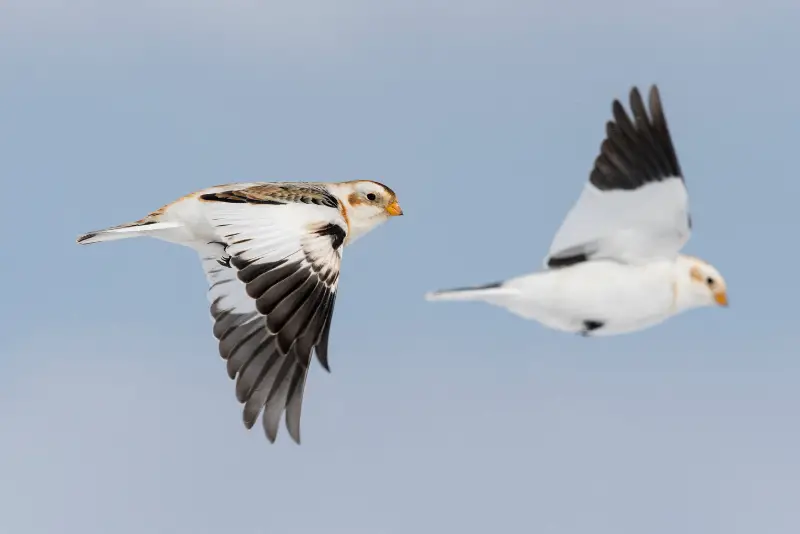
Snow Buntings are small songbirds that breed in the arctic tundra, but migrate south in winter, showing up in large flocks in southern Canada and the northern United States.
During the breeding season, males are mostly white, except for their black shoulders, wingtips, and tail feathers. Females are more drab, with a mix of grayish brown and dirty white.
During the winter, these small white birds acquire a more brownish white color, which helps them to blend in with the surroundings in their winter quarters.
Final remarks
In summary, here are the 13 types of white colored birds with black tipped wings:
- Snow Goose
- Swallow-tailed Kite
- American White Pelican
- White Ibis
- Whooping Crane
- Ring-billed Gull
- Laughing Gull
- Herring Gull
- Bonaparte’s Gull
- Franklin’s Gull
- California Gull
- Northern Gannet
- Snow Bunting
If you’ve spotted one of these birds while bird watching, hopefully this ID guide will help you identify it quickly and easily.
And if you enjoyed this article, check out our guide to the types of red birds with black wings.


